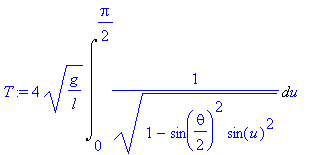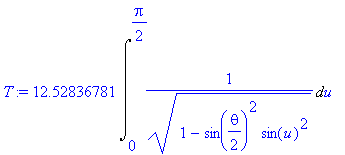
Gymnasieopgave: Pendulet
| > | restart;with(plots): |
Warning, the name changecoords has been redefined
******************************************************************************
Formlen for svingningstiden er
| > | f:=1/sqrt(1-sin(theta/2)^2*sin(u)^2); |

| > | T:=4*sqrt(g/l)*Int(f,u=0..Pi/2); |

Opgave 1
For
![]() = 0 finder vi f = 1 altså bliver intgralet = 2
= 0 finder vi f = 1 altså bliver intgralet = 2
![]()
| > | limit(T,theta=0); |
![]()
Opgave 2
Vi laver en Taylorudvikling af integranden og sætter
| > | t:=sin(theta/2)^2*sin(u)^2; |
| > | h:=(1-x)^(-1/2); |
| > | p:=taylor(h,x=0,2); |
| > | p:=convert(p,polynom); |

![]()
![]()
![]()
Vi indsætter det tilnærmede udtryk i T og integrerer
| > | p:=subs(x=t,p); |
| > | T_ny:=4*sqrt(g/l)*int(p,u=0..Pi/2); |


Vi indsætter l = 1.00 meter og g = 9,81 meter i T og plotter udtrykket
| > | T_ny:=evalf(subs(g=9.81,l=1.0,T_ny)); |
| > | T:=subs(g=9.81,l=1.0,T); |
![]()

Et plot for
![]() = 0..
= 0..
![]() viser hvor god tilnærmelsen er
viser hvor god tilnærmelsen er
| > | plot([T_ny,T],theta=0..Pi/2,0..25,numpoints=100); |
![[Maple Plot]](images/pendulet16.gif)
| > |
| > |